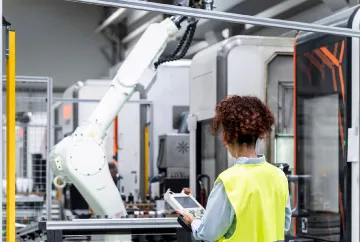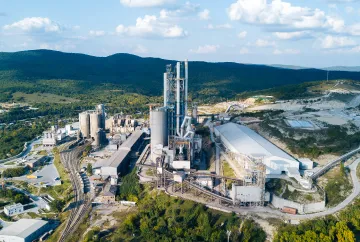Overview
The automotive industry has been undergoing waves of digital transformation for over a decade now. With numerous digital systems driving manufacturing, automotive manufacturers now have a wealth of data at their hands. However, most are yet to unleash the power of this data and bridge the gap that separates their manufacturing facilities from the plants of the future.
Our client, one of the world’s top engine manufacturers, was finding it difficult to transform the data available through various operational and IT systems into insights. They were also facing challenges with building visibility at the plant and the business unit (BU) level, experiencing rising production costs, suboptimal throughput, and increasing machine downtime across their plants.
To address these challenges, the client engaged Birlasoft to transform its engine manufacturing facilities into plants of the future – in other words, to unleash the power of data to fully optimize operations, and drive better decisioning. Birlasoft leveraged its deep expertise in automotive manufacturing, data engineering, and machine learning to achieve IT-OT (Information technology – operational technology) convergence through a scalable, interoperable, and extensible analytics solution – ultimately enabling the client to gain granular and top-level visibility into its operations through 85+ real-time KPIs. Read the detailed aspects of this engagement below.
Key Challenge
1. Inability to generate insights from high volumes of data generated by IT and OT systems
Modern manufacturers leverage a variety of systems like product lifecycle management (PLM) and enterprise resource planning (ERP) in addition to SCADA systems, integrated manufacturing platforms, and control systems to drive processes in the back office and on the shop floor.
The client had already implemented these systems and was leveraging Apriso for manufacturing execution (MES). This was integrated with the ERP and the PLM to drive quality control, generate a bill of materials (BOM), plan processes, and orchestrate maintenance and repair operations (MRO). These systems were generating terabytes of valuable data that could provide valuable insights into production, maintenance, and quality assurance processes. However, our client was unable to build a solution that could turn this data into usable insights across the spectrum of its operations. Moreover, the existing MES was not being exploited to its full potential, where it could enable plant-level visibility and traceability into products, processes, and materials.
Our client saw a significant opportunity in this data and wanted to utilize it to drive improved decisioning and process orchestration across its manufacturing facilities.
2. Lack of real-time visibility resulting from difficulty in creating and tracking meaningful KPIs
Engine manufacturing is a highly complex process that entails multiple stages from concept to design, production, and sales. Therefore, production performance can be influenced by numerous factors, including, but not limited to asset reliability, quality control, production schedule, resource utilization, supplier relations, supply chain factors, and so on. Without complete visibility and control over these factors, it is not possible to ensure that each plant is running at maximal performance.
Operations spanning over multiple countries, our client was finding it challenging to achieve this requisite visibility into key performance indicators (KPIs) across its facilities. This was making it difficult to respond effectively to evolving conditions at the plant level. Moreover, without visibility into production performance, our client was unable to infer whether its plants were running at optimal levels. This made it impossible to improve the existing output and performance of its manufacturing facilities.
3. Unexplained increases in operational costs affecting profitability
Because engine manufacturing involves multiple stages involving complex processes, there are numerous factors that contribute to the operational costs of a manufacturing plant. In the absence of visibility at the process level, it is not possible to conduct detailed cost analyses. This is usually a consequence of the unavailability of operational data, or the inability to analyze and interpret it in time and at a massive scale.
In the case of our client, this lack of process-level visibility was making it difficult to pinpoint the root cause of rising operational costs. Without detailed insights into cost drivers, the right cost-saving measures cannot be implemented – and this ultimately affects the profitability and the bottom line of the business. To address this issue, our client wanted to implement advanced analytics which would enable them to track the factors influencing operational costs at a granular level.
4. Increased machine downtime across locations adding to lost revenues
Machine downtime is one of the leading causes of lost revenues for manufacturers. The cost of this downtime is increasing, and Fortune 500 companies lose nearly 11% of their yearly turnover due to asset downtime. What’s more, the cost of unexpected downtime of critical machinery is even higher, and it can jeopardize production by necessitating plant-wide shutdowns for repair operations.
While our client was leveraging a global manufacturing platform to orchestrate maintenance and repair operations, they lacked plant-wide visibility into machine health. This led to the use of legacy maintenance practices like reactive and preemptive maintenance, which causes breakdowns or over-maintenance. Machine downtime was disrupting production schedules and increasing maintenance costs. In addition, suboptimal plant uptime was also adding to the company’s lost revenues.
5. Reduced machine productivity and throughput eroding competitiveness
As machines age, they may start functioning sub optimally and may warrant more proactive maintenance and repair. Moreover, frequent breakdowns ultimately subtract the remaining useful life (RUL) of the machine, while lowering the throughput of the plant. However, low throughput can also be attributed to inefficient manufacturing processes which can be difficult to spot in high-complexity procedures like engine manufacturing.
Our client was experiencing reduced throughput and suboptimal machine productivity across plants. This was impacting their competitiveness in global markets, negatively affecting the production volume, and contributing to lost revenues. Building systematic, real-time visibility into plant operations was the only way to pinpoint the root cause and make targeted interventions for maximizing throughput.
Birlasoft Solution
To address the above challenges, the client engaged Birlasoft to transform its digitally-enabled engine manufacturing facilities into plants of the future. Birlasoft deployed a team of data engineering and machine learning experts with expertise in automotive manufacturing to build a unified KPI model, a system of predictive and diagnostic insights, and digital twins to transform the manufacturing operations for the client. Read the details of the solution below.
Birlasoft stepped in to deliver a robust and comprehensive test automation and continuous testing solution for the client. With a strategic approach encompassing multiple technologies and a focus on efficiency, Birlasoft embarked on a transformative journey to revolutionize the client's testing landscape.1. Interoperable, extensible, secure, and configurable data architecture to support analytics at scale
In order to support real-time visibility across the expanse of the client’s operations, Birlasoft spotted the need for building a highly scalable data maintenance interface (DMI) platform. This platform would facilitate the provision of data from ERP, MES, SCADA, PLM, automated manufacturing systems (AMS), and other enterprise software deployed across facilities to power dashboards and reports for various user personas. Birlasoft designed this platform with the capability to integrate with different enterprise systems, which communicated with varying data connectivity and communication protocols.
Moreover, the platform was designed to support 1000+ connected assets and hundreds of concurrent users, while ensuring security across all layers of the stack. Because data analytics solutions in manufacturing carry sensitive information about production processes, Birlasoft designed the system to ensure security by default at the network, user, asset, and plant levels. Finally, Birlasoft implemented the DMI system on Microsoft Azure to support the computation and data throughput demands of the use case.
The end result was a performant data architecture that could support the analytics and reporting needs of hundreds of users and exploit real-time data from hundreds of machines across multiple plants.
2. Role-based insights to build situational awareness and drive improved decisioning
The client wanted to implement a reporting system that would serve the needs of various personas, and enable data-driven decisioning at scale across the organization. In other words, it had to serve business roles like planners and regional managers, and engineering roles like plant operators, supervisors and technicians. To deliver relevant insights to each of these roles, Birlasoft devised unified KPI models that would bring real-time visibility at the plant and the line level through metrics like overall equipment effectiveness (OEE), first time right (FTR), mean time between failures (MTBF), mean time to repair (MTTR), cost of goods sold (COGS), value-added per person (VAPP), and so on.
In total, 85+ KPIs were implemented to achieve visibility at the plant level. These metrics could then be used by the client to make more informed decisions on the shop floor and within the maintenance and repair function. Moreover, KPIs like VAPP, total preventive maintenance, COGS, and other cost data from the MIS could now inform detailed cost analyses and help the client pinpoint the cause of rising operational costs.
3. Unified data model to exploit process data for achieving IT-OT convergence
Finally, the unified KPI model which enabled real-time visibility, and the intelligence templates which powered the system of insights for production, asset, performance, and energy domains were leveraged to build digital twins and threads. Digital twins and threads are a digital replica of the physical plants and processes as and how they occur in real-time. This system is now powering value chain optimization and operations optimization across product management, manufacturing, and after-sales at the client’s organization.
By contextualizing the data within the IT systems with that of the OT systems, it is possible to gain unique insights into bottlenecks and sources of inefficiency within complex production processes. Our client could now leverage the digital twins to fully optimize their operations and unleash maximum productivity across all plants.
4. Alarms and alerts to drive more responsive MRO across all plants
Engine manufacturing facilities are dynamic environments, where operating conditions and machine behavior can change within a matter of seconds. Ultimately, the ability to respond to changes in machine condition, and scheduling maintenance and repair tasks with precision is crucial to maximize machine uptime and OEE.
To enable this, Birlasoft configured intelligent alarms and alerts that could notify plant operators of relevant changes in production KPIs, machine health metrics, and energy consumption patterns in real time. This helped them make targeted interventions to restore processes to their normal state and optimize maintenance to maintain machine reliability. These measures enabled the client to maximize production throughput and mitigate lost revenues that were caused by machine downtime.
Key Business Benefits/Impact
By transforming the client’s manufacturing facilities into plants of the future with a scalable analytics and reporting solution, Birlasoft delivered the following benefits to the client:
1. Increased OEE from real-time alerting and machine health monitoring
Machine health monitoring capability and alerts for deviation from normal machine behavior enabled increased OEE across all plant locations.
2. Enhanced worker productivity resulting from plant and line-level visibility
Role-based KPIs and insights into performance across domains enabled engineering and business teams to make more informed decisions based on data instead of searching for the root cause of issues.
3. Reduction in the cost of quality with diagnostic and predictive system of insights
Real-time visibility enabled process stabilization and insights into quality assurance (QA) processes enabling the client to further optimize operations, enabling improved production quality at lower costs than before.
4. Reduced time to market and marked decrease in GHG emissions
The digital twins and threads solution offered deep insights into energy consumption, process bottlenecks, and capacity improvement opportunities, thereby reducing time to market and GHG emissions linked to energy consumption.
5. Increased throughput and machine uptime enabling higher revenues
Finally, improved machine uptime and availability enabled increased production throughput and mitigated the lost revenues that resulted from suboptimal


